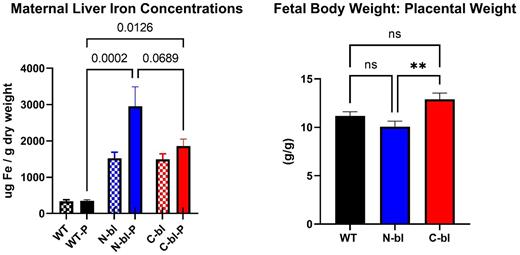Abstract
Introduction: Iron deficiency anemia during pregnancy is associated with adverse outcomes for mother and fetus. These include increased risk for perinatal death, preterm birth, and cognitive defects in childhood. Defining and achieving optimal iron status requires a better understanding of the mechanisms responsible for the normal adaptive processes to maternal iron homeostasis and erythropoiesis during pregnancy. Marked changes in maternal iron metabolism serve to maximize fetal iron availability. These include a fall in maternal hepcidin levels despite decreased iron stores and relative suppression of maternal erythropoiesis despite increased maternal erythropoietin levels. The molecular mechanisms by which these two major changes in iron metabolism occur remain to be defined. We propose that transferrin-mediated signaling events contribute to each. Specifically, we hypothesize that decreased iron occupancy of the N-lobe confers a down-regulatory signal on maternal hepcidin and epo responsiveness during pregnancy.
Methods: We investigated the effect of lobe specificity of iron binding to transferrin (Tf) with wild-type (wt), N-blocked and C-blocked Tf mutant maternal mice fed a standard iron diet during their pregnancy. We compared erythropoietic parameters, serum hepcidin levels, renal erythropoietin, placental weight and fetal weight assessed at ~E18.
Results: Compared to wt maternal mice, N-blocked and C-blocked monoferric mice had lower hemoglobin concentrations (12.4 + 0.9 vs 10.1 + 0.5 and 9.9 + 0.65 g/dL; p <0.0001). Despite similar hemoglobin concentrations between the monoferric strains, renal erythropoietin expression was higher in the N-blocked dams than in the C-blocked dams (-11.46 +.24 vs -12.71 + 0.63 -delta Cq relative to beta-actin; p < 0.01). Each of the monoferric strains had higher serum iron than wt, (198.3 + 22.9, 170.4 + 13.3 and 118.4 + 33 for the N-blocked, C-blocked and wt respectively, p < 0.05). Liver iron concentrations were likewise higher in each of the monoferric mutant dams compared to wt, with the N-blocked dams being the highest (2950 + 1209, 1856 + 476.8 and 635.2 + 698.5 ug Fe/g dry weight for N-blocked, C-blocked, and wt; p < 0.01). By contrast, the N-blocked mice had a greater decrease in splenic iron during pregnancy compared with C-blocked. Serum hepcidin levels were decreased relative to non-pregnant mice in all three strains, and similar in N-blocked and C-blocked mice. N-blocked dams had fewer fetuses than wt dams (6.3 + 1.6 vs 8.7 + 0.8 pups/litter). Compared to C-blocked mice, N-blocked mice had lower fetal weights (0.87 + 0.2 vs 0.99 + 0.16 g; p < 0.01) but greater placental weights (0.091 + 0.02 vs 0.079 + 0.02 g; p < 0.01).
Conclusions: N-blocked dams demonstrate a higher serum erythropoietin level compared with C-blocked dams despite a similar hemoglobin, consistent with previous reports of relative erythropoietin resistance in these mice. N-blocked dams moreover demonstrate iron overload without a compensatory increase in serum hepcidin, consistent with dampened signaling of iron status in hepcidin regulation. The increased placental and decreased fetal weights in N-blocked dams suggest a deleterious effect on placental efficiency. We speculate that lack of iron occupancy in the Tf N-lobe confers an iron-depletion signal in the regulation of maternal iron metabolism and erythropoiesis in pregnancy.
Disclosures
Parrow:Protagonist: Consultancy. Fleming:Silence Therapeutics: Consultancy; Ultragenyx: Research Funding; Protagonist Therapeutics: Consultancy.
Author notes
Asterisk with author names denotes non-ASH members.


